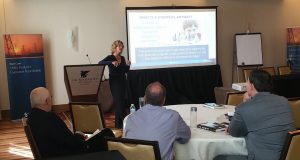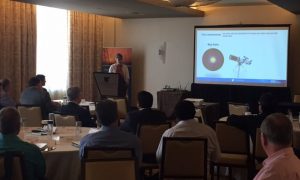 Utilities, like all large organizations, spend a lot of time and resources on strategy. But how do utility analytics leaders ensure that their efforts are connected to this high-level vision?
Utilities, like all large organizations, spend a lot of time and resources on strategy. But how do utility analytics leaders ensure that their efforts are connected to this high-level vision?
On June 28th in Los Angeles, a small gathering of utility executives and analytics leaders met to discuss and explore how analytics could be, and should be, aligning with a utility’s corporate strategy. This meeting, known as the West Coast Utility Executive Roundtable, brought together analytics leaders from west coast utilities, as well as thought leaders from the SAS Institute Best Practices group and the Utilities Practice Partner from McKinsey & Company. The following provides a few of the highlights and insights from the roundtable.
The opening keynote session featured a compelling call to tie analytics to organizational strategy from Jill Dyché, Vice President of the SAS Best Practices group, and Mallik Angalakudati, Vice President of Corporate Strategy at PG&E.
The utility landscape is changing quickly, said Mallik, especially in terms of how the traditional central generation to transmission to distribution to customer is changing. This has many implications, including how utilities should be providing base load generation, which is complex because of the long planning windows in building and decommissioning large-scale power plants; how utilities engage customers, which needs to change now that there are more choices for most utility customers; and how utilities hire, as there are many new skill sets required to run the utility of tomorrow in addition to the skills that are required today and will be required into the foreseeable future.
One potential game changer also emerged from Mallik’s remarks: energy storage. As the price of batteries continues to drop, the changes to how electricity is generated, used, and paid for will change dramatically.
Start with corporate strategy

Jill Dyché implored the audience to use corporate strategy to drive analytics strategy. Speaking from her wealth of experience across multiple vertical industries to drive this message home, Jill noted that:
- It’s not where you are now, it’s where you want to be.
- Most companies are now or have recently revised their corporate strategies to be more customer-focused, and that drills down to data.
- What’s important to your company [read: your executives and board] is important for BI.
- If BI supports an already-articulated strategy, you’re more likely to get executive support –and funding!
- Strategy is likely to be rigorously considered, and thus less subject to politics.
She also shared some sage advice on choosing analytics projects based on corporate priorities/strategy, noting that this usually comes down to one or more of the four criteria:
- Increase customer satisfaction.
- Increase customer acquisition rates.
- Decrease cost per revenue dollar.
- Increase revenue per transaction.
If your analytics project is not aligned with one or more of these criteria, don’t do it!
The roundtable audience was also fortunate to hear from Adrian Booth, Partner at McKinsey & Company, who drew from his work with utilities as well as broader analytics research and engagements from across McKinsey. Adrian noted that in addition to the combination of data, technology algorithms and front line applications successful analytics initiatives often are:
- Embedded in frontline applications, used by analytic power users, or used by regular end users with special easy-to-use tools, such as Tableau.
- Using new computer-intensive methods to handle 1,000s of variable and explore all possible correlations, especially Machine Learning.
- Integrating external data sets to create large “data lakes” to be mined.
- Including new big data technology (Hadoop, for instance) capable of processing massive amounts of data quickly.
Trends to watch in analytics
Adrian also noted four mega-trends that are driving growth in analytics in organizations:
- More devices to collect data (IoT): More devices (IoT) coming online to provide measurement and reporting, and in some cases proactive functionality or control.
- New data sources: A massive wave of new data sources is becoming available, both internally and from third parties.
- More powerful technologies: Billions of dollars of investment is spawning a complex ecosystem of new analytics vendors and solutions.
- Lower processing and storage costs: Moore’s Law creates cheaper, more powerful processors to analyze greater volumes of data in greater velocity.
Wrapping up his remarks, Adrian noted five key learnings from the experience of leading analytics professional and executives.
- Follow the value: Start from the business problems you want to solve.
- Start from “small” data: the data already available is typically sufficient to build well-performing models.
- Do not overinvest in IT: develop technical infrastructure only when your business case is clear.
- Set-up the supporting operating model, including:
- Organize a center of competence to drive and replicate Advanced Analytics efforts across different applications.
- Go beyond models: create holistic solutions including a new organizational model, processes, and capability building.
- Apply rapid prototyping: Try, test, (fail) and restart. Don’t be afraid to “Beta” and learn from mistakes.
- Have an overall roadmap: use a phased approach to reach the competitive advantage.
Three challenges for utility executives
Tamara Dull, Director of Emerging Technologies in the SAS Best Practices group, challenged the audience with three questions.

How is big data different from IoT? The two are linked, but understanding how each of these can play a role in improving organizational effectiveness is key. What are the investments required in each of these areas and how is ROI determined? Important considerations as the scope – and expense – of technology can grow quickly.
What keeps them from coming back for more? In a world of competing priorities making analytics a core part of a business leader’s daily life is critical. This goes back to Jill Dyché’s guidance on tying analytics to the business strategy. If that strategic initiative is critical to the success or failure of the business, make darn sure that the analytics are communicating the initiative’s criticality.
Are definitions a help or a hindrance? Tamara asked the audience about the importance of how we – as well as industry analysts - define much of what we do. Where does BI end and analytics start? What is included in “smart grid”? How do we define goals and objectives and how we will reach them? Subtle considerations, but nonetheless important when large analytics and IT investments are on the table.
This inaugural one-day roundtable session provided actionable insights for its attendees as well as a great opportunity to network with and learn from other utility analytics leaders in attendance. Watch for an east coast edition of this roundtable coming later in 2016!
Learn more about advanced analytics for the utilities industry.

